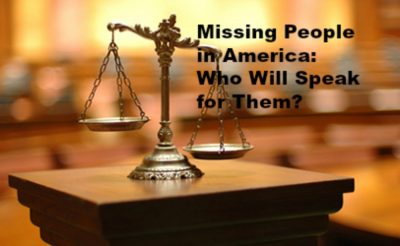
Alive, Dead, Presumed Dead
Sometimes I am asked to find people who live on the fringe of society. Most of the time I seek out people who lost touch with their parents family groups and there are no hard feelings. Occasionally I need to find someone who has walked away from the family and they want nothing to do with ‘those people’.
What to do if you have a missing family member?
Have you checked with everyone you can think of that the missing person might be in touch with? Yes? Then it’s time to file a missing person report with the local police department. The police will check their databases to see if this person comes up or not. If the individual is alive then the police can make contact. If the police find nothing they will take a report. Ask your local police department about updating the National Missing and Unidentified Persons System, or NamUs.
You can also put the information for your missing person at Missing Persons of America. Here is a link to the Missing in the United States Map on their site.
One of my recent cases asked me to prove a missing person in their probate case was dead. After doing the initial investigation I asked the daughter to file a missing person’s report. It was then that the daughter discovered her father was alive and well.
The final conclusion
There is so much that can be written about this. If you are interested in learning more continue reading. Below you will find links to articles as well as discovering how the medical examiner’s and coroner’s offices deal with the cases of the missing. [Not well at best.]
Have they died and a local coroner’s office was unable to identify your family member?
There are many instances of people who have died in the United States where a local coroner’s office was unable to identify the person. That individual would have been buried as a John Doe or a Jane Doe, or even Baby Doe. DNA will be one of the clues to open up these cases. So many people are never reported as missing. They die quietly somewhere with no identifying information on or near the body and their family cannot be notified.
Here is an article from September 2, 2015, Left for dead: How America fails the missing and unidentified. This takes a few minutes to read but I hope you’ll take the time to review it. The information is just as relevant today as it was a year ago when the article was written. We need to find better ways to notify families of deaths. While I understand medical examiners and coroner’s offices are working with tight budgets waiting for someone to do the footwork for them free isn’t acceptable. There are families actively looking for their family members.
Additionally, there is not a national database of medical examiner’s or coroner’s offices. Every state varies as to whether they have centralized reporting or not. The best I could locate was this information from the U.S. Department of Justice, Medical Examiners and Coroners’ Offices, 2004. There on page one was a map stating that only 16 States had a centralized statewide medical examiner system. It went on to say that 14 states had a county coroner system, and 7 had a county medical examiner system. I could find no current information on this since 2004. I did find a more interactive map on pbs.org but it appears to be the same information as above. Map Death in America lacks a date on the information but from comments it was posted about 2010. There are a number of websites but most do not have dates indicating [to me] that the website considers the information to be of evergreen content.
Finding out what has happened to our loved ones takes time and effort. If you have someone missing in your family I hope you are getting help in having the name of the person placed in the databases.
Contact me: If you have questions about locating missing heirs to your client’s estates please contact me at Leslie@LawsonResearch.net. I’m more than happy to help you understand my process to locate the missing heirs to your case.
